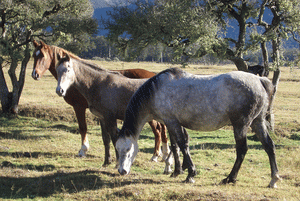Species
Equus caballus
Common Name(s)
Feral horse
Family
Equidae
Habitat
Feral horses mainly occur in open habitat including grassland and open forest or shrub.
They are herbivorous, mainly feeding on grasses, clovers, sedges and annual herbs. Horse need to drink water every day.
Description
 Hardly mistaken for other large mammal species due to their large size, unique mane and tails and distinct long-muzzled heads.
Hardly mistaken for other large mammal species due to their large size, unique mane and tails and distinct long-muzzled heads.
Threat To Plants
Trampling (especially in wet areas) and grazing of plant species which may alter species regeneration and vegetation composition.
Distribution
Two remaining North Island populations : Kainmamawa (near Waiouru) and Aupouri (near Ninety Mile Beach).
Measurements
Around 1350-1500 mm (withers hight)
Year Introduced
1814 (Bay of Islands)
Reason For Introduction
Transportation and draught animal
Colonisation History
First introduced to New Zealand at the Bay of Island by Samuel Marsden in 1814. Further early introductions include Akaroa in 1836 (23 individuals) and Wellington 1840 (military). By 1850 horses were the main form of transportation. All over the country escapes and strays assembled in wild herds and by 1920 feral horse were common over much of the North Island with smaller population on the South and Chatham Islands. Since then numbers have largely been reduced and currently only two populations remain on the North Island.